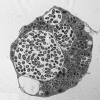Mycobacterium and the coat of many lipids
- PMID: 12147678
- PMCID: PMC2173834
- DOI: 10.1083/jcb.200205034
Mycobacterium and the coat of many lipids
Abstract
Pathogenic Mycobacterium reside inside vacuoles in their host macrophages. These vacuoles fail to fuse with lysosomes yet interact with early endosomes. Glycoconjugates released by the intracellular bacilli traffic through the host cell and are released through exocytosis. These molecules represent both antigens for immune recognition and modulators of immune function. The molecules play key roles in the induction and maintenance of the granuloma, a tissue response that limits bacterial spread yet ensures persistence of the infection.
Figures




References
-
- Beatty, W.B., E.R. Rhoades, H.J. Ullrich, D. Chatterjee, and D.G. Russell. 2000. Trafficking and release of mycobacterial lipids from infected macrophages. Traffic. 1:235–247. - PubMed
-
- Beatty, W.L., H.J. Ullrich, and D.G. Russell. 2001. Mycobacterial surface moieties are released from infected macrophages by a constitutive exocytic event. Eur. J. Cell Biol. 80:31–40. - PubMed
-
- Besra, G.S., and D. Chatterjee. 1994. Lipids and carbohydrates of Mycobacterium tuberculosis. Tuberculosis: Pathogenesis, Protection, and Control. B.R. Bloom, editor. ASM Press, Washington, D.C. 285–306.
-
- Brightbill, H.D., D.H. Libraty, S.R. Krutzik, R.B. Yang, J.T. Belisle, J.R. Bleharski, M. Maitland, M.V. Norgard, S.E. Plevy, S.T. Smale, et al. 1999. Host defense mechanisms triggered by microbial lipoproteins through toll-like receptors. Science. 285:732–736. - PubMed
Publication types
MeSH terms
Substances
Grants and funding
LinkOut - more resources
Full Text Sources
Other Literature Sources
Medical

